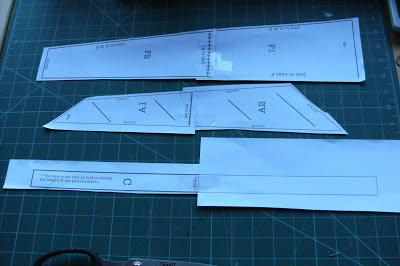The Bee blocks that I made, I blogged about HERE, and were made following a pattern by Anna Maria Horner, and templates had to be made.
I don't use templates all that much, but do teach how to make them because you never know when you will fall for a pattern that calls for them.
This is how I make them.
First of all, I print off the pattern. PDF files always open up on my computer at 133% so I go to the toolbar on the PDF document and resize to 100%. Then as I prepare to print, I make sure it will print to size, with no scaling. If your pattern is from a book, then you might need to trace it.
I then cut out all the separate pieces, but not accurately yet. Leave a bit of space all around each shape.
Some of my shapes had to be joined to make a larger shape.
In this particular set of shapes, there was one that had a fold line. I laid this fold line on the edge of a piece of paper, underneath the paper, and held it up against a window, before drawing around the shape. I then matched the short edges making one pattern piece.(bottom piece in picture)
Templates can of course, be traced directly on to template plastic. Sometimes you don't have any to hand, can't get a hold of the right kind quickly, or in this case big enough for the shapes. And that is why you need to save your cereal packets. I like its weight for template making. But for these I found some card left over from Christmas packaging. It was a tiny bit heavier than I like, I find corrugated cardboard too thick.
Anyway, grab a gluestick, and stick your shapes down onto the card.
Now it's time to cut the shapes accurately. I used a craft knife and my quilter's ruler but you could also use sharp craft scissors.
And that is all there is to it. You now have a set of templates that can be used more than once.
To use my templates, I chose to use a soft pencil to mark onto my fabric. These particular templates were quite long, so I used my rotary cutter and ruler to cut along the marked lines, but of course you could just use sharp scissors. Sometimes I use an ordinary biro pen to make marks, I tend to avoid the air / water erasable pens as the marks don't last long enough to see to work with.
I find that blocks made using templates usually come out a little larger than by rotary methods.Every little step, from tracing through glueing thro cutting and then marking on to fabric adds miniscule amounts in size. If you plan to mix template made blocks with rotary cut blocks, be sure to check individual block sizes before joining. Adjustments might be necessary.







Very useful especially as I still have to tackle this block although I did do some print outs and instructions as I thought it might be easier to read on paper than on the screen!
ReplyDeleteAh, well that answers how those feathers are put together then! (I've never actually looked before!)
ReplyDeleteI too need to tackle these blocks so your tutorial is very welcome :) Di x
ReplyDeleteGreat tute S and v.useful as working with templates definitely throws off accuracy sometimes. Jxo
ReplyDeleteThis is helpful, I have only made templates a couple of times.
ReplyDeleteYour right Sheila. I learn everything from the intent and sometimes I don't know how to do the basic things, so I just make it up. And trust me its not always right! This is very useful, thanks.
ReplyDeleteA great tutorial!
ReplyDeleteI love those feathers by AMH, and I must admit the thought of using a template is a touch off putting. I guess it's no different then using a clear ruler to cut your shapes though when I think about it? Great tutorial!
ReplyDeleteIt is certainly amazing how retracing, cutting, snipping and so on...all create teeny additions to final measurements...
ReplyDeletea bit like eating one more bickie, really.